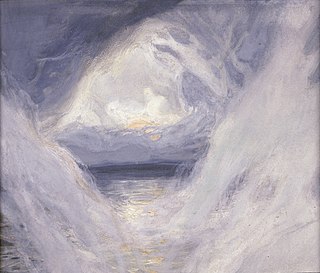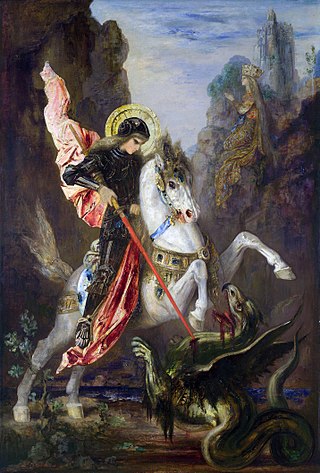
A creation myth or cosmogonic myth is a type of cosmogony, a symbolic narrative of how the world began and how people first came to inhabit it. While in popular usage the term myth often refers to false or fanciful stories, members of cultures often ascribe varying degrees of truth to their creation myths. In the society in which it is told, a creation myth is usually regarded as conveying profound truths – metaphorically, symbolically, historically, or literally. They are commonly, although not always, considered cosmogonical myths – that is, they describe the ordering of the cosmos from a state of chaos or amorphousness.

Christian mythology is the body of myths associated with Christianity. The term encompasses a broad variety of legends and narratives, especially those considered sacred narratives. Mythological themes and elements occur throughout Christian literature, including recurring myths such as ascending a mountain, the axis mundi, myths of combat, descent into the Underworld, accounts of a dying-and-rising god, a flood myth, stories about the founding of a tribe or city, and myths about great heroes of the past, paradises, and self-sacrifice.
Religion and mythology differ in scope but have overlapping aspects. Both are systems of concepts that are of high importance to a certain community, making statements concerning the supernatural or sacred. Generally, mythology is considered one component or aspect of religion. Religion is the broader term: besides mythological aspects, it includes aspects of ritual, morality, theology, and mystical experience. A given mythology is almost always associated with a certain religion such as Greek mythology with Ancient Greek religion. Disconnected from its religious system, a myth may lose its immediate relevance to the community and evolve—away from sacred importance—into a legend or folktale.

A dying-and-rising, death-rebirth, or resurrection deity is a religious motif in which a god or goddess dies and is resurrected. Examples of gods who die and later return to life are most often cited from the religions of the ancient Near East. The traditions influenced by them include the Greco-Roman mythology. The concept of a dying-and-rising god was first proposed in comparative mythology by James Frazer's seminal The Golden Bough (1890). Frazer associated the motif with fertility rites surrounding the yearly cycle of vegetation. Frazer cited the examples of Osiris, Tammuz, Adonis and Attis, Zagreus, Dionysus, and Jesus.

James Arthur Baldwin was an American writer and civil rights activist who garnered acclaim for his essays, novels, plays, and poems. His 1953 novel Go Tell It on the Mountain has been ranked among the best English-language novels. His 1955 essay collection Notes of a Native Son helped establish his reputation as a voice for human equality. Baldwin was a well-known public figure and orator, especially during the civil rights movement in the United States.
Richard Warrington Baldwin Lewis was an American literary scholar and critic. He gained a wider reputation when he won a 1976 Pulitzer Prize for Biography or Autobiography, the first National Book Critics Circle Award for nonfiction, and a Bancroft Prize for his biography of Edith Wharton. The New York Times called the book "a beautifully wrought, rounded portrait of the whole woman, including the part of her that remained in shade during her life" and said that the "expansive, elegant biography ... can stand as literature, if nothing else."
Jaan Puhvel is an Estonian comparative linguist and comparative mythologist who specializes in Indo-European studies.

The Ainu historically have their own language and a rich repertoire of oral literature. The stories are particularly delivered through the genre of Kamui Yukar, which are long narratives of heroic exploits involving spiritual beings such as animals, plants, and natural phenomena. As result of assimilation, most of the Ainu people are Japanese speakers and do not speak the Ainu language. The literature now exists in forms of written texts which have been fixed but still remain to be many versions of the same tales. The Ainu creation myths are the traditional creation accounts of the Ainu peoples of Japan. These myths reflect the Ainu worldview that attributes subjectivity and agency to nonhuman entities, considering them as conscious beings with the ability to communicate and interact with humans. Although Ainu mythology has characteristics in common with the Japanese, whom they have interacted with for since the early 19th century, their creation myth remains their own.

The creation of life from clay can be seen as a miraculous birth theme that appears throughout world religions and mythologies. It can also be seen as one of gods who craft humans out of earthly materials. As such, this class of story falls within a larger set of divine or cosmogonic origin stories about creation, whether through divine emergence or divine craft.
Margaret Randolph Higonnet is an American author, teacher and historian who currently serves as a Professor Emerita at University of Connecticut.
Rosalie Littell Colie (1924-1972) was a professor of comparative literature, a specialist in Renaissance English literature, and a poet.





